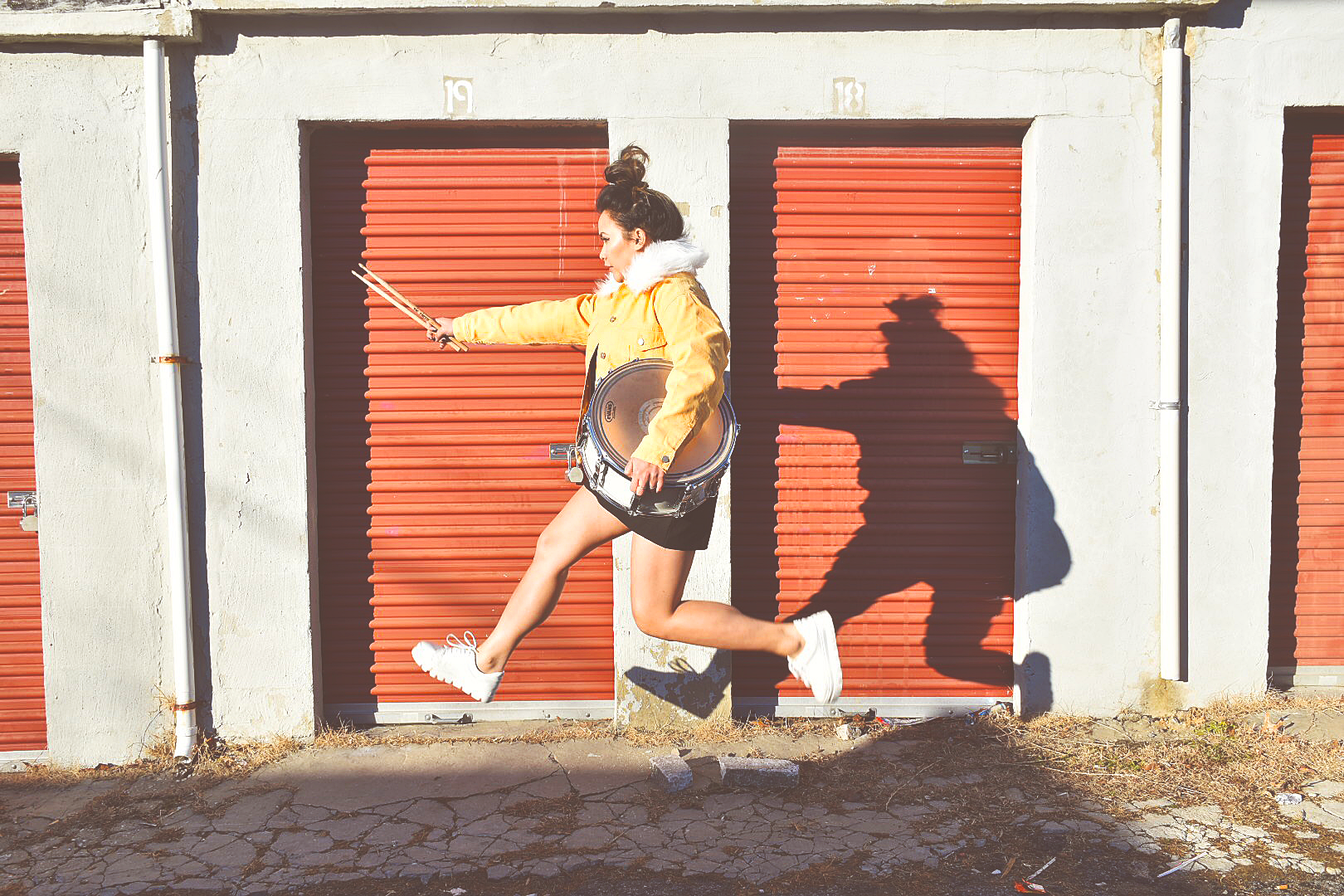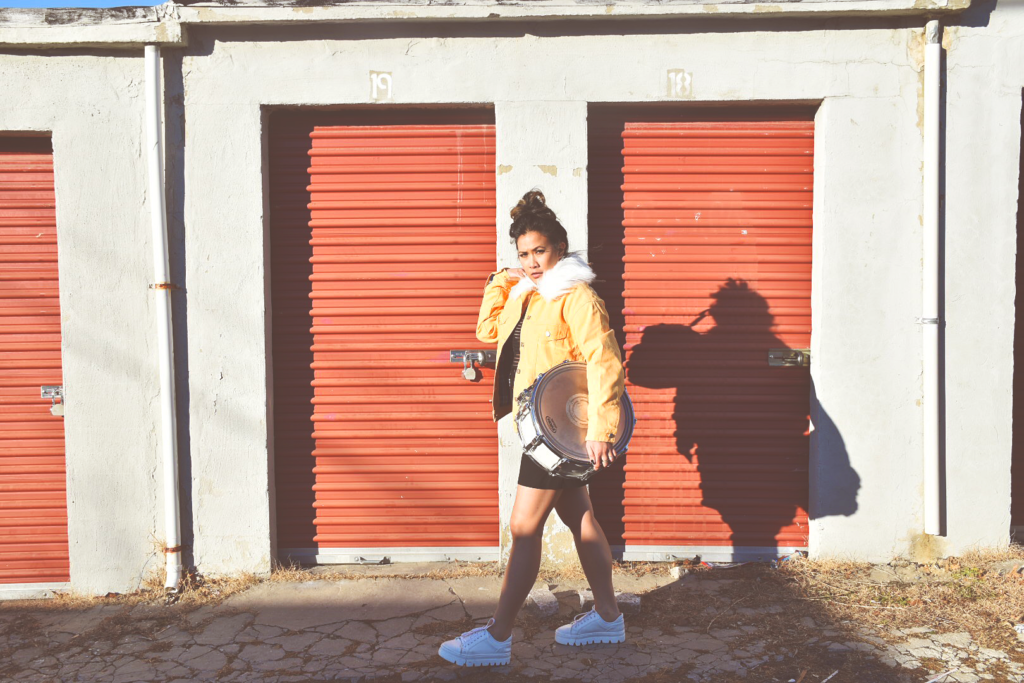Words By Kyle Kelly-Yahner
Photos By Kristine De Leon
The Family Band
“First of all, what were we doing at a bar?”
Isabelle De Leon was 13 at the time, playing a bar gig with her sisters. Her younger sister on guitar was 11 years old. Her oldest sister on bass was still many years shy of the legal drinking age.
Accompanying the band of sisters was Isabelle’s dad; the sisters’ mentor, manager, and legally required chaperone. He built out a recording studio in their basement so the band could practice. He wrote out charts and arrangements. He insisted on versatility, teaching each sister to play piano, bass, guitar, and drums before they decided which instrument to stick with.
Isabelle chose drums at the age of seven when her Dad brought home a fiery red Tama Starclassic — she still has the kit.
Isabelle recalls a moment sitting behind that Starclassic in a smoky Maryland bar; flanked by her sisters, where she started digging into the tunes and experimenting with her stage presence. “I started rocking out,” says Isabelle. “People loved seeing these young kids playing.”
Over a decade later, Isabelle has graduated from bar gigs. She tours with pop group Prinze George, sheds with drum demi-god Aaron Spears, and teaches aspiring drummers the skills they need to find their voice on drums.
Going for It
Isabelle’s strong musical foundation is not uncommon. But her work to unpack that foundation, take inventory of it, and build it up is.
We’re in an age where three year olds have a greater than zero chance of stealing your gigs. They’re unlikely to wax philosophical about beat placement, but they’re still placing beats well. When you start playing young like Isabelle did, you can develop your foundation of timing, feel, and groove without realizing it’s happening. “You don’t really question it or think of the obstacles behind it, you kind of just pick it up. Kids are so fearless, and just go for things,” says Isabelle.
Isabelle took drum lessons from age seven on, developing tangible skills like sight reading alongside more ethereal skills like playing in the pocket. Regularly playing with her sisters gave Isabelle the chance to gut-check what she’d worked on in lessons, narrowing the gap between practice and performance.
“That didn’t resonate with me until I was a little older — seeing how much learning piano helped me with learning the drums and vice versa. I think constantly being surrounded by it gave us a big step up as far as understanding music and the nuances.”
Keying in on nuances is how you find yourself playing John Bonham transcriptions at an early age.
Underestimating the Power of Concert DVDs
At home, Isabelle’s parents played Led Zeppelin’s “The Song Remains the Same” DVD, Kenny Loggins’ live concert album, “Outside: From the Redwoods,” Earth, Wind & Fire LPs and everything else from Mariah Carey to Lenny Kravitz.
Isabelle’s tastes in drumming circled around a style. Bonham was one of the first drummers Isabelle imitated. Her dad was a huge Led Zeppelin fan. He had Isabelle reading through transcriptions, and playing along with recordings. Bonham planted the seed for Isabelle’s high-energy, aggressive playing style — and led her to Cindy Blackman.
Isabelle had never seen a female drummer play live until she saw Cindy Blackman. Witnessing Cindy commanding Lenny Kravitz’s grooves with power and confidence was a watershed moment for Isabelle. The fact that Cindy was doing it all in a bikini added to the allure.
“Once I started studying jazz, I naturally gravitated to some of the later, more aggressive drummers who paved the way for fusion jazz, like Elvin Jones and Tony Williams. When I learned that Cindy was basically a Tony Williams protégé of sorts, it all clicked and I realized why I loved Tony and this kind of aggressive style of playing.”
She pursued that style, primarily honing her voice in a rock setting. Jazz was (and is) an entirely different beast. Isabelle learned that lesson the hard way at the University of Maryland.

Sight-reading Blinders
Isabelle could bank on her sight reading in lessons, she admits. “I was a very strong sight reader. A lot of my teachers, when I was taking lessons, they just gave me a lot of material to read and because I could read it so fast, I got really complacent.” This skill gave her the option of reviewing an assigned piece of music beforehand, or putting it off until she had to perform it during the lesson. The outcome was the same: She breezed through the charts.
“I would practice usually the night before my lessons, or not at all. My teacher would pull out all these books I was reading through and I would sight read perfectly.” This did not fly in the University of Maryland’s Jazz Program.
Isabelle’s high school drum instructor helped prepare her for her audition into the program. She was accepted, but had never played in any jazz groups. The gap between ability, which she had in spades, and experience was immediately apparent.
“I had no idea what I was doing. Here I was on the first week of school playing with these kids who had played in four years of big band, playing in combos, doing gigs and stuff. I felt so shitty because I was that person who was dragging everyone down.”
“I felt like I wanted to quit the first week,” Isabelle says. “They were like ‘Alright, trade fours,’ and I had no idea what to do.”
She went home and told her dad she wanted to quit. He convinced her otherwise.
“That’s when I really started becoming my own teacher,” says Isabelle.
Teaching Yourself to Teach … Yourself
Today, Isabelle regularly teaches students at 7DrumCity in Washington, D.C. She asks students what their goals are, assesses the areas that need improvement, and creates detailed practice programs for them. Her instruction style stems from her freshman year at school.
Isabelle’s musical foundation got her to the UMD Jazz Program, but it wouldn’t keep her there without some work.
“I said ‘Alright, I really need to step my game up, catch up to all these people, and learn this music,’” Isabelle remembers.
This was the first time Isabelle was responsible for creating a practice program. She just had to do it for herself.
Back in the basement at home, Isabelle developed her ear for melody by playing piano. She learned to play in the pocket by practicing and performing with her sisters and other groups. She learned song structure playing in church and writing her own songs. Improvement came through performance, and typically happened on a subconscious level.
“It was just a feeling,” says Isabelle.
To catch up at the University of Maryland, Isabelle had to audit herself and take stock of what needed work. She was not only conscious of what skills she had to improve, but also the required pace of improvement. She kept a transcription-heavy diet, analyzing the grooves played by legends. Her college drum teacher, Chuck Redd, led her on a path through the history of jazz drumming. She started with Gene Krupa and Papa Jo Jones. Next came Art Blakey, Philly Jo Jones, and Max Roach. During her senior year, she was pouring over Roy Haynes, Elvin Jones, and Tony Williams.
She notated beats, solos, and licks that caught her ear; transcribing her favorite contemporary drummers like Steve Gaad, Dave Weckl, and Eric Harland.
“I thought, this is what I should be doing in order to get to this place. It was a big learning curve for me. It was a little rough in the beginning, but I put in a lot of work and finally caught up. By the next year I was already in the top jazz ensemble, in the top combo, and feeling a lot more confident.”
The Right Practice
Isabelle’s freshman year really paid off. She graduated on the Dean’s List with a degree in Jazz Drum Performance and that wasn’t the only degree she earned. As if jazz alone isn’t challenging enough, Isabelle completed a pre-medicine track to set her up to apply to medical school.
She now splits her time between teaching at 7DrumCity, gigging in D.C., and touring with Prinze George. Isabelle has exited the days of tirelessly working in dimly lit college practice spaces and now shares stages with Local Natives and Cold War Kids. But, the lessons from freshman year keep her, and her students, focused when she’s home.
“Because of that first year of being uncomfortable and feeling kind of stuck, I made it a mission that when I started teaching, I’d first find out what my students’ goals are and based on that, design a curriculum for them to get there.”
Getting there means doing what Isabelle calls the “unsexy” work. Yes, she is explicitly referring to hours of rudiments and drills accompanied by a metronome. There will always be unsexy work to do to improve your game whether that’s hours of pouring over Alan Dawson’s Rudimental Ritual, or hours of improvising; it’s likely both. The challenge isn’t doing the work as much as it is recognizing the right work to do and that’s a skill Isabelle’s constantly working on.
Keep Up With Isabelle De Leon
Facebook/Instagram/Website/YouTube
Keep Up With Kyle
Kyle is a San Francisco-based drummer and writer.
Website/Instagram


